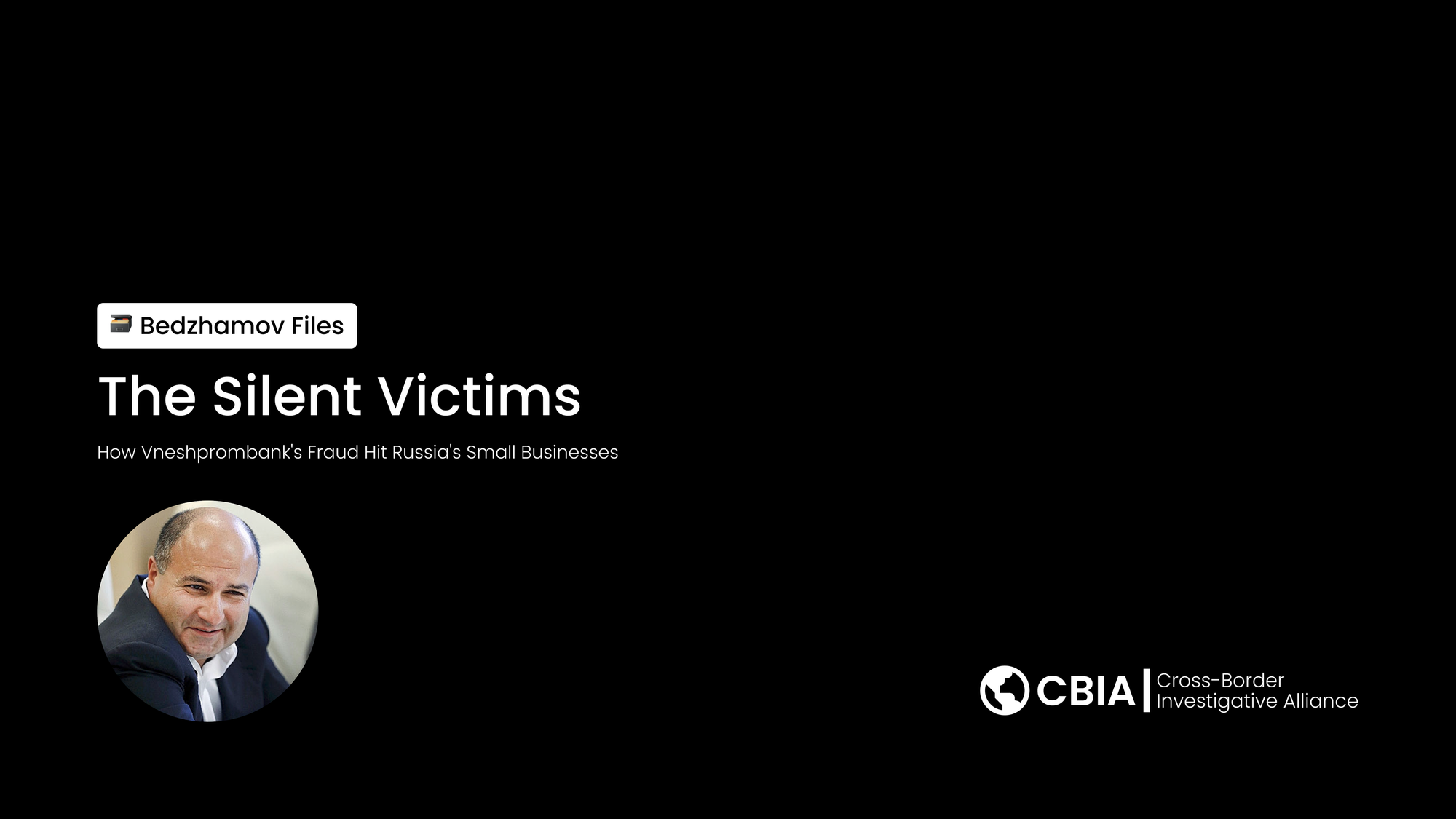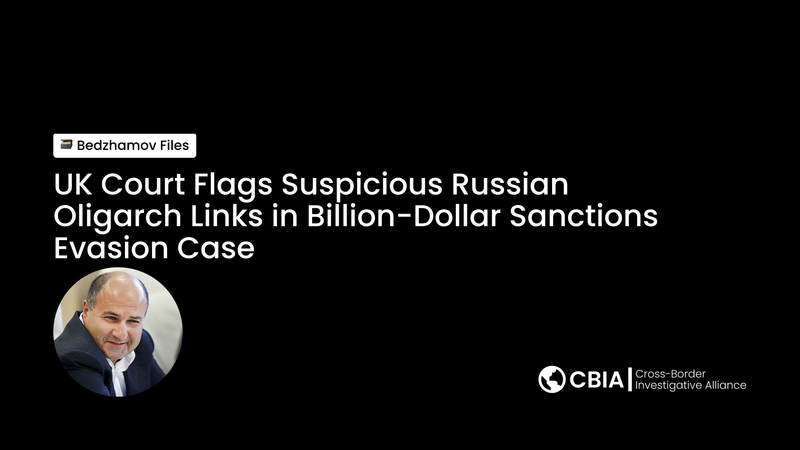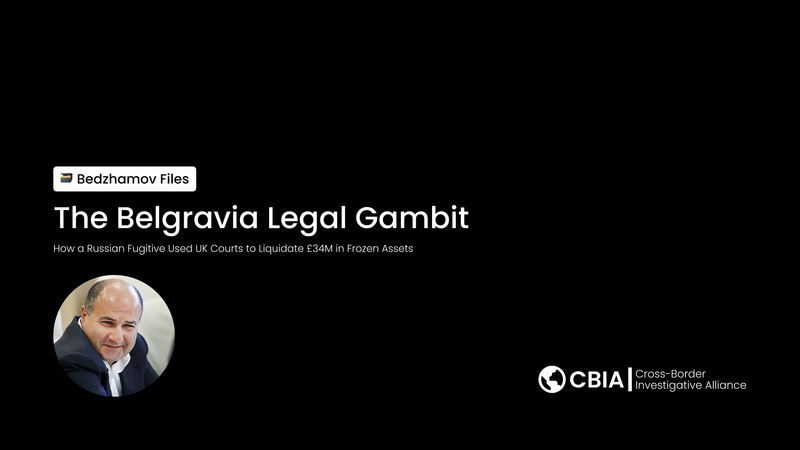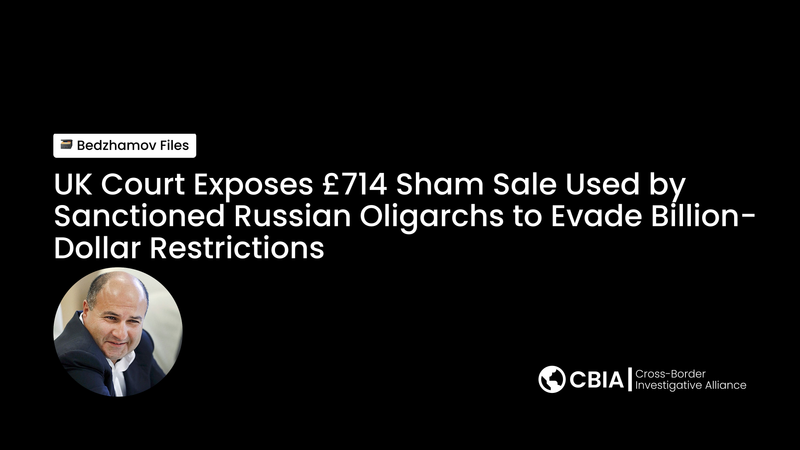The Silent Victims: How Vneshprombank's Fraud Hit Russia's Small Businesses

When the Safe Became Empty: A Story of Broken Trust
Imagine you own a small bakery. Every day, you work hard, serving fresh bread to your neighbors. At the end of each day, you carefully count your earnings and deposit them in what you believe is a safe, trusted bank. Then one morning, you wake up to discover that the bank has disappeared overnight - and with it, all your money. The cash you needed to buy flour, pay your workers, and keep your shop running is simply gone.
This isn't just a scary story. It's exactly what happened to thousands of small business owners across Russia when Vneshprombank collapsed in January 2016, taking with it 156 billion rubles (about $1.5 billion) that belonged to ordinary people and small companies.
While the bank's former owner, Georgy Bedzhamov, now lives comfortably in London mansions worth tens of millions of dollars, the small businesses that trusted him with their savings are still struggling to survive - and many never recovered at all.
The Bank That Looked Safe But Wasn't
Vneshprombank seemed like a solid choice for small businesses. It was Russia's 40th largest bank by assets according to the Interfax-100 ranking, making it appear stable and trustworthy. For small business owners - people who run corner shops, repair services, small restaurants, and family companies - this bank offered something precious: a place to safely store their hard-earned money.
But appearances can be deceiving. Behind the respectable facade, bank executives were running one of the most devastating financial frauds in Russian history. Like thieves with keys to the vault, they were systematically stealing money from the very people who trusted them to keep it safe.
The scheme was breathtakingly simple in its dishonesty. Bank executives would create fake companies - like setting up pretend businesses that existed only on paper. They would then "lend" money to these fake companies, knowing the loans would never be repaid because the companies didn't really exist. This way, they could transfer money from real depositors' accounts into their own pockets.
When regulators finally discovered the fraud, they found a financial "hole" of 210.1 billion rubles - setting a record for the largest excess of liabilities over assets in Russian banking history.
The Day Everything Changed: January 21, 2016
For thousands of small business owners, January 21, 2016, started like any other day. They had no idea that by evening, their financial lives would be turned upside down.
That morning, Russia's Central Bank made a devastating announcement: Vneshprombank's banking license was being revoked, and a moratorium was being imposed on satisfying creditors' claims. In simple terms, this meant the bank was immediately shut down, and all the money inside was frozen.
Think about what this meant for a small business owner. Imagine Maria, who runs a small clothing store. She had just received payment from customers the day before and deposited it in her Vneshprombank account, planning to use that money to buy new inventory for the spring season. Suddenly, she couldn't access any of her funds. She couldn't pay her suppliers, couldn't pay her rent, and couldn't even pay her employees.
Or consider Viktor, who owned a small construction company. He had been saving money in Vneshprombank for months to buy new equipment. In one day, years of careful saving vanished, leaving him unable to grow his business or even maintain his current operations.
The Crushing Numbers: Who Lost What
The scale of the disaster was enormous. About 10,000 creditors, including depositors and individual entrepreneurs, lost a total of 81 billion rubles ($1.2 billion) when Vneshprombank collapsed. These weren't wealthy oligarchs or big corporations - these were ordinary people and small businesses that formed the backbone of Russia's economy.
To understand the impact, let's break down what "10,000 creditors" really means:
Individual Entrepreneurs: In Russia, many small business owners register as "individual entrepreneurs" - a simple business structure similar to sole proprietorships in other countries. These are people who run single-person businesses, family companies, and small operations with just a few employees. They depend entirely on their business income to survive.
Small Companies: These included family-owned shops, local service providers, small manufacturers, and regional businesses that employed dozens of people in their communities.
Regular Depositors: Ordinary citizens who had saved their money in what they thought was a safe bank.
The average loss per small business was devastating. While some large depositors lost millions, the typical small business or individual entrepreneur lost hundreds of thousands of rubles - often representing months or years of careful saving.
The Broken Promise of Protection
Russia, like many countries, has a deposit insurance system designed to protect people when banks fail. The Bank of Russia announced that payments to Vneshprombank depositors, including individual entrepreneurs, would start no later than 14 days after the moratorium was imposed.
This sounded reassuring, but the reality was much harsher. The deposit insurance system had strict limits. For small businesses and individual entrepreneurs, insurance coverage is limited to 1.4 million rubles per bank - roughly $17,000 at 2016 exchange rates.
For many small businesses, this wasn't nearly enough. A successful small restaurant might have several million rubles in working capital. A small manufacturing company might have even more. When the insurance payments finally came through, many businesses received only a tiny fraction of what they had lost.
Think of it like this: if your house burned down and your insurance only covered the cost of one room, you'd still be homeless. That's what happened to these businesses - they got some money back, but nowhere near enough to survive.
The Contrast That Stings: Luxury vs. Loss
While thousands of small business owners struggled to keep their companies alive, Georgy Bedzhamov - the man accused of stealing their money - was living a very different life.
Court documents reveal that Bedzhamov owns luxury properties in London worth an estimated $50 million. These aren't just houses - they're mansions in some of London's most exclusive neighborhoods, complete with elegant gardens and premium locations.
The contrast is heartbreaking. Maria, the clothing store owner we mentioned earlier, might have lost her entire life savings of 2 million rubles (about $25,000). Meanwhile, Bedzhamov's London mansion alone is worth 2,000 times more than what she lost. It's like a thief stealing someone's bicycle while driving away in a gold-plated sports car.
Among Vneshprombank's depositors affected by the collapse were several VIPs, including family members of Russian government members and government ministries. But unlike ordinary small business owners, these powerful depositors had resources and connections to pursue their claims more aggressively.
Real Stories, Real Pain: What Businesses Actually Lost
While we can't name specific victims (to protect their privacy), the types of losses experienced by small businesses were both predictable and tragic:
Working Capital Wipeout: Many businesses kept their day-to-day operating cash in Vneshprombank accounts. When these funds disappeared, they couldn't pay suppliers, employees, or rent. Imagine a small bakery that suddenly couldn't buy flour or pay its bakers - it would have to close within days.
Investment Funds Lost: Some businesses had been saving money for expansion, new equipment, or renovations. Years of careful planning and saving were wiped out overnight. A small repair shop that had saved for two years to buy new diagnostic equipment suddenly had to abandon its growth plans.
Payroll Disasters: Businesses that kept payroll funds in Vneshprombank faced immediate crises. They had to choose between borrowing money at high interest rates to pay employees or laying off workers they couldn't afford to pay.
Supply Chain Breakdowns: Many small businesses had standing orders with suppliers, paid through Vneshprombank accounts. When payments stopped flowing, suppliers cut off deliveries, forcing businesses to scramble for alternative arrangements they often couldn't afford.
The Ripple Effect: When Small Businesses Fail, Communities Suffer
The collapse of Vneshprombank didn't just hurt business owners - it sent shockwaves through entire communities. When small businesses fail, the effects spread like circles in a pond:
Job Losses: Each failed small business meant unemployed workers. A construction company that employed 15 people didn't just lose its owner's savings - it put 15 families at risk of losing their income.
Service Gaps: When local businesses close, communities lose essential services. The neighborhood repair shop, the local grocery store, the family restaurant - these businesses provide services that larger companies often don't offer in smaller towns and rural areas.
Economic Decline: Small businesses are often anchor points for local economies. When they fail, property values can decline, other businesses lose customers, and entire neighborhoods can begin to deteriorate.
Trust Erosion: Perhaps most damaging of all, the Vneshprombank collapse destroyed trust in the banking system among small business owners. Many became reluctant to deposit large sums in any bank, limiting their ability to grow and invest.
The Recovery That Never Came
In the years following Vneshprombank's collapse, the bank's liquidation process has been a study in frustration for small business victims. The creditor register closed on May 18, 2016, with total claims reaching 215 billion rubles ($3.2 billion).
But recovering assets has proven nearly impossible. The bank's liquidators have managed to recover only a tiny fraction of the stolen money. Most of the assets were hidden in complex offshore structures or converted into luxury real estate in foreign countries - far beyond the reach of small business owners who lack the resources for international legal battles.
For the typical small business victim, the process has been both expensive and futile. Imagine trying to sue someone who has hidden your money in multiple countries, using lawyers who charge more per hour than you make in a month. It's like trying to catch a thief who has already moved to another planet.
Why Small Businesses Were Sitting Ducks
The Vneshprombank fraud revealed several weaknesses in how Russia's financial system protects small businesses:
Inadequate Insurance Coverage: The 1.4 million ruble insurance limit was far too low for most functioning small businesses. A successful small company might need several million rubles in working capital just to operate normally.
Limited Due Diligence Resources: Unlike large corporations that can afford to investigate their banks' financial health, small businesses typically lack the resources to verify that their chosen bank is truly safe. They must rely on regulatory oversight and public reputation.
Weak Recovery Mechanisms: When things go wrong, small businesses don't have the legal resources or political connections to pursue complex asset recovery cases. They're essentially powerless against sophisticated financial fraud.
Systemic Vulnerability: Small businesses often concentrate their banking relationships with one institution for simplicity and cost reasons. This makes them extremely vulnerable when that institution fails.
The International Dimension: Justice Denied
The story becomes even more frustrating when we consider the international aspects of the case. Vneshprombank filed a £1.34 billion lawsuit against Bedzhamov in London courts, attempting to recover stolen assets for the victims.
But this legal process has been slow, expensive, and largely ineffective at helping the original small business victims. The complexities of international law, the costs of cross-border litigation, and the sophisticated asset-hiding techniques used by financial criminals have created a system where justice is theoretically possible but practically unreachable for ordinary people.
Meanwhile, Bedzhamov has successfully avoided extradition and continues to enjoy his luxury lifestyle in London. He was briefly arrested in Monaco in April 2016 but was released and has remained free since.
The message this sends to small business owners is clear: if someone steals your money and is sophisticated enough to hide it internationally, you're unlikely to ever see justice.
Lessons for the Future: What Needs to Change
The Vneshprombank disaster offers important lessons for protecting small businesses from similar fraud:
Higher Insurance Limits: Deposit insurance limits need to reflect the actual cash needs of functioning small businesses, not just individual savings accounts. A limit of 1.4 million rubles might protect a family's savings, but it's inadequate for a business that needs working capital.
Better Early Warning Systems: Regulators need more effective ways to detect and stop financial fraud before it reaches catastrophic proportions. The fact that 156 billion rubles could be stolen over several years suggests that oversight systems failed.
Simplified Recovery Processes: When banks fail, there should be faster, cheaper ways for small business victims to recover their losses. The current system is too complex and expensive for ordinary business owners to navigate.
International Cooperation: Countries need better mechanisms for pursuing financial criminals who flee abroad with stolen assets. The current system allows sophisticated thieves to simply move to another jurisdiction and enjoy their crimes' proceeds.
Alternative Protection: Small businesses might need specialized banking services or insurance products that provide better protection than the standard deposit insurance system designed for individual consumers.
The Ongoing Struggle: Where Things Stand Today
As of 2024, most Vneshprombank victims have received little beyond the initial insurance payments. The bank's liquidation continues, but the chances of significant additional recovery appear slim. The Deposit Insurance Agency hired investment company A1 (part of the Russian Alfa Group) to search for Bedzhamov's hidden assets in Russia and the UK, but these efforts have yielded minimal results for ordinary victims.
The small businesses that survived the initial shock have largely had to rebuild from scratch, often taking on debt or selling personal assets to keep their companies alive. Many never fully recovered, operating at smaller scales than before or eventually closing altogether.
Meanwhile, the legal proceedings against Bedzhamov continue in various jurisdictions, but these complex international cases offer little hope for the typical small business victim who needs compensation now, not after years of expensive litigation.
A System That Fails Its Most Vulnerable
The Vneshprombank case reveals a troubling truth about modern financial systems: they're often better at protecting the wealthy than the vulnerable. Large corporations and wealthy individuals have the resources to diversify their banking relationships, investigate their financial institutions, and pursue complex legal remedies when things go wrong.
Small businesses have none of these advantages. They must trust the system to protect them, and when that system fails, they have few options for recovery. They're like small boats in a storm, while the people who caused the storm sail away in luxury yachts.
This creates a moral crisis for any society that values entrepreneurship and small business development. If the people who start small companies, create local jobs, and serve their communities can lose everything to financial fraud with no realistic hope of recovery, what does that say about the fairness of the economic system?
The Human Cost of Financial Crime
Behind every statistic about Vneshprombank's collapse is a human story of dreams deferred, plans abandoned, and lives disrupted. The 10,000 small business creditors weren't just numbers in a ledger - they were people who had worked hard, saved carefully, and trusted their money to what appeared to be a legitimate institution.
Some were first-generation entrepreneurs who had invested their life savings in starting a business. Others were second or third-generation family business owners who lost not just money, but companies that had been built over decades. Still others were young people whose business plans were destroyed before they could even fully implement them.
The psychological impact goes beyond the financial losses. Many victims report feeling betrayed, not just by the bank executives who stole their money, but by a system that seemed designed to protect criminals while abandoning victims. This erosion of trust has lasting effects on their willingness to take business risks, invest in growth, or participate fully in the formal economy.
Looking Forward: The Need for Systemic Change
The Vneshprombank case isn't just ancient history - it's a warning about ongoing vulnerabilities in financial systems around the world. As financial crimes become more sophisticated and international in scope, the gap between criminals' capabilities and victims' protections continues to widen.
For small businesses specifically, several reforms could help prevent similar disasters:
Risk-Based Insurance: Instead of flat insurance limits, deposit protection could be tied to the actual business needs of different types of companies. A construction company legitimately needs more working capital than a consulting firm.
Transparency Requirements: Banks could be required to provide more detailed, understandable information about their financial health and risk management practices, written in language that small business owners can understand.
Rapid Response Systems: When banks fail, there should be emergency mechanisms to provide immediate bridge financing to small businesses, preventing the cascade of failures that occurs when businesses suddenly can't access their working capital.
Victim Advocacy: There should be specialized institutions or ombudsmen whose job is specifically to help small business victims of financial crime navigate recovery processes and access available resources.
International Frameworks: Countries should develop standardized systems for cooperating in asset recovery cases, making it harder for financial criminals to simply flee to jurisdictions where they can enjoy their stolen wealth.
Conclusion: The Price of Unequal Justice
The story of Vneshprombank's small business victims is ultimately a story about fairness - or the lack of it - in modern financial systems. When Georgy Bedzhamov allegedly stole 156 billion rubles, he didn't just take money from a bank's balance sheet. He stole the dreams, plans, and security of thousands of small business owners who had done nothing wrong except trust the wrong institution.
Today, while Bedzhamov lives in luxury London mansions worth tens of millions of dollars, the small businesses that trusted him with their savings continue to struggle with the consequences of his alleged crimes. Many never recovered. Many never will.
This disparity - between the comfortable life of the accused criminal and the ongoing hardship of his victims - represents a fundamental failure of justice. It sends a clear message: if you're sophisticated enough to commit international financial crimes and hide the proceeds abroad, you can likely escape the consequences. But if you're an ordinary small business owner who becomes a victim of such crimes, you're largely on your own.
The Vneshprombank case should serve as a wake-up call for policymakers, regulators, and financial institutions. Small businesses are the backbone of most economies, providing jobs, services, and innovation at the community level. When the financial system fails to protect them - or worse, when it enables their victimization - the entire economic ecosystem suffers.
Eight years after Vneshprombank's collapse, most of its small business victims are still waiting for justice. They're still waiting for their money. They're still waiting for someone to care about their losses as much as they care about pursuing the high-profile international legal cases.
Their continued suffering, contrasted with Bedzhamov's continued comfort, stands as a stark reminder that in the world of international finance, justice is often less about right and wrong than it is about resources and reach. Until this changes, small businesses will remain vulnerable to the next sophisticated financial criminal who decides their savings are worth stealing.
For now, the silent victims of Vneshprombank's fraud continue their wait - not just for compensation, but for a financial system that values their protection as much as it values the pursuit of profit. Their story is far from over, but sadly, for many, the ending has already been written: dreams deferred, businesses destroyed, and trust permanently broken.
Sources and Verification
Primary Legal and Regulatory Sources
Bank of Russia Official Announcements:
· Bank of Russia - Moratorium on Vneshprombank Creditor Claims - Official announcement of banking license revocation and deposit insurance activation
· Bank of Russia - Banking Sector Overview - Current deposit insurance limits and small business coverage
Russian Legal Information Agency (RAPSI):
· RAPSI - Vneshprombank Executive Sentencing - Details on criminal convictions and organized crime findings
· RAPSI - Bankruptcy Proceedings Extension - Moscow Commercial Court proceedings against Bedzhamov
UK Court Records:
· UK Court of Appeal - Vneshprombank LLC v Bedzhamov [2019] EWCA Civ 1992 - Official court judgment on asset recovery case
· Blackstone Chambers - Case Summary - Legal analysis of £1.34 billion fraud claim
· vLex Legal Database - Case Documentation - Comprehensive case law documentation
Financial Industry and Analysis Sources
S&P Global Market Intelligence:
· S&P Global - Vneshprombank Collapse Analysis - Professional banking sector analysis and impact assessment
The Interpreter Magazine:
· Russia Update - Creditor Analysis - Detailed breakdown of 10,000 creditors and 81 billion ruble impact on small businesses and individual entrepreneurs
EU Reporter:
· EU Reporter - International Asset Recovery Efforts - Coverage of DIA's use of A1 (Alfa Group) for asset recovery
Investigative Journalism Sources
Organized Crime and Corruption Reporting Project (OCCRP):
· OCCRP - Pandora Papers Investigation - Detailed investigation into how Bedzhamov used offshore structures to hide stolen assets
Russian Information Sources:
· RusLetter - Vneshprombank Organization Profile - Comprehensive background on bank structure and collapse
· TAdviser - Bedzhamov Profile - Detailed biography and criminal case information
Academic and Policy Analysis
Taylor & Francis Academic Publications:
· Post-Communist Economies Journal - Scholarly analysis of deposit insurance system failures in Russia
International Monetary Fund:
· IMF Russia Financial Sector Assessment - Official assessment of Russian banking sector vulnerabilities
Deposit Insurance Documentation
Bank of Russia Deposit Insurance:
· CBR Small Enterprise Insurance Coverage - Official policy on 1.4 million ruble coverage limit for small businesses
· Wikipedia - Deposit Insurance Agency - Overview of Russian deposit protection system





